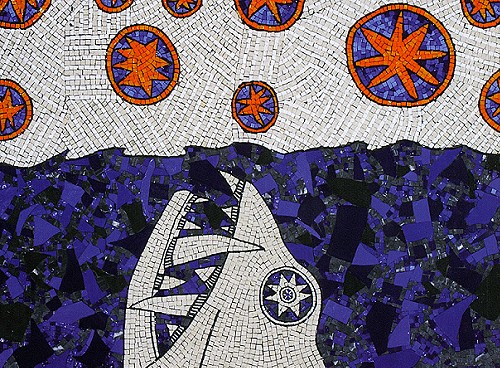
Everything comes from the sea: this is the finding that prompted multifaceted Italian artist Oreste Baldini to devote his energies to the sea and the icon of the fish.
From the sea came life, from the sea came the first nourishment for humans.
A nourishment, which provided humans with the energy to aspire to the skies.
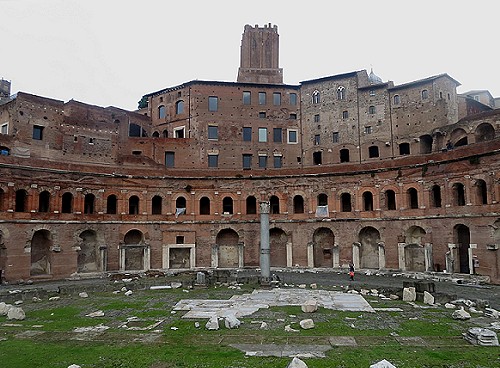 The exhibition in Rome (Italy) is open until 12 January 2014. The scenery is unparalleled, unrepeatable and suggestively related to the sea and the life that man draws: the Via Biberatica of Trajan's Markets.
The exhibition in Rome (Italy) is open until 12 January 2014. The scenery is unparalleled, unrepeatable and suggestively related to the sea and the life that man draws: the Via Biberatica of Trajan's Markets.
Emperor Marcus Ulpius Trajan was born in Italica in the region of Baetica (modern Andalusia in Spain). The Forum Traianum was commissioned by him and built in 113 A.D. as the work of a great Nabataean architect: Apollodorus of Damascus. Though the markets are only a small part of the Forum, they are today the best preserved part.
The architect was thus born in a town located on the opposite shore of the Mediterranean from the birth place of his client. A melting pot that blended Arabic and Greek civilisation, considered the oldest city in the world: Damascus is home to traces of human settlements dating back to 9,000 years before our era.
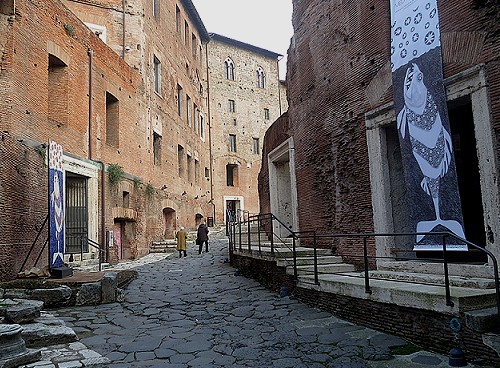 A magic encounter between different cultures made possible, once again, by the Mediterranean.
A magic encounter between different cultures made possible, once again, by the Mediterranean.
The Via Biberatica extends into the upper part of the hemicycle facing the forums and overlooking the tabernae (shops or taverns) dedicated to the trade of beverages and liquids in general.
These included garum, a liquid formed by the fermentation of fish guts that was ubiquitous in the ancient Mediterranean cuisine, probably derived originally from the fish, which the Greeks called garos (γάρον).
The large top-layer stones that make up the surface of the millennial Via Biberatica have supported the footsteps of many generations of human beings, while the interior of the tabernae witnessed countless fruitful trade and cultural exchanges.
.
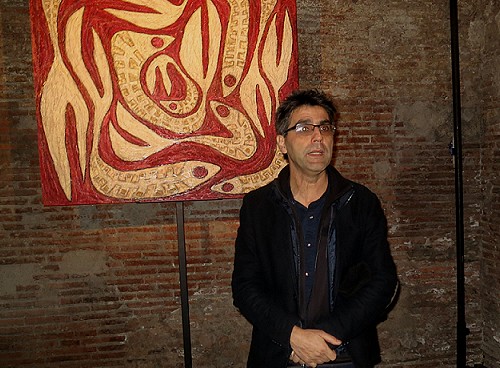
And it is the artist himself, Oreste Baldini, who guides us to explore the exhibition "Mediterraneum".
And off we go towards the re-discovery of what we are guilty of condemning to deterioration and extinction one day soon, without realising that the degradation of the sea leads as a logical consequence to the decay of the human being himself and all his aspirations...
... and - hopefully - although not necessarily, we may rediscover the sea and the respect for aquatic life, but return also to appreciate the Civilisation of the Sea.
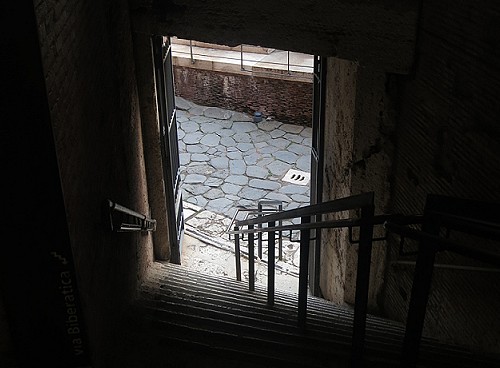 The majestic entrance of the Trajan's Markets is placed at a higher level, because the building is leaning on the Quirinal Hill. Access from the floor of the Imperial Forums was blocked by buildings constructed centuries if not millennia later.
The majestic entrance of the Trajan's Markets is placed at a higher level, because the building is leaning on the Quirinal Hill. Access from the floor of the Imperial Forums was blocked by buildings constructed centuries if not millennia later.
A steep staircase takes us to the hemicycle. With its shabby appearance, it seems at first sight to lead to a dark dungeon.
But at the end you see the light to which the visitor is attracted, even without any other indications.
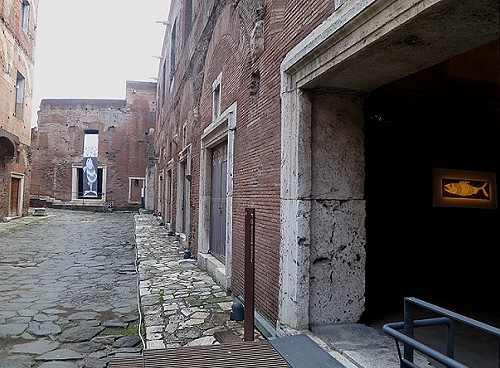 The old access to Via Biberatica probably started from here, and it is from here that the visit Mediterraneum starts, even though the stairway is further off, around the corner.
The old access to Via Biberatica probably started from here, and it is from here that the visit Mediterraneum starts, even though the stairway is further off, around the corner.
On the left, unfortunately not accessible for visitors, the tabernae are home to the world's most important collection of Roman amphorae from transport. The stamps of manufacturers, traders and imperial officials in charge of supplies will the day come back to attract an interest in our past. They will allow to reconstruct the dense texture of human relations across the Mediterranean: this is what one of the civilisations that arose and flourished there simply called Mare Nostrum.
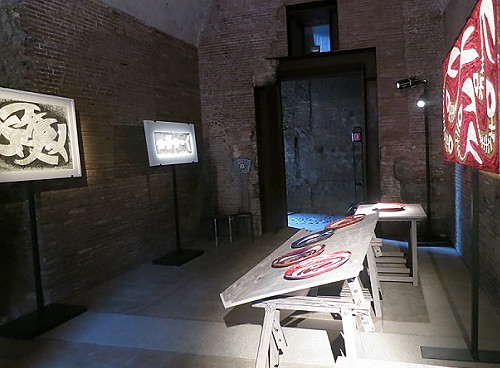 On the right, the Mediterraneum exhibition begins with a theme that is material only apparences: the sea as a source of food and livelihood, including an economy of its own.
On the right, the Mediterraneum exhibition begins with a theme that is material only apparences: the sea as a source of food and livelihood, including an economy of its own.
The tables set up inside the tabernae are periodically filled with food from the sea and from the land, processed exclusively at artisanal scale and offered to visitors.
It is intended to return visitors to an earlier, more primitive, food in a quite material way, and in any case also trigger a cultural awakening that is late in arriving in contemporary society.
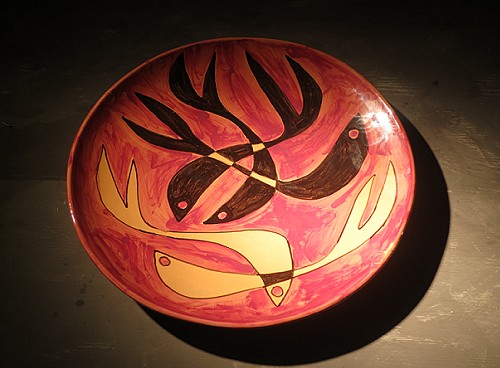 The techniques used by Oreste Baldini for the creation of his art works are varied.
The techniques used by Oreste Baldini for the creation of his art works are varied.
Some are ispired by classical or popular art which developed all around the Mediterranean, others are entirely original.
These polycrome plates seem to make reference to many artifacts handed down to us from Greek civilisation.
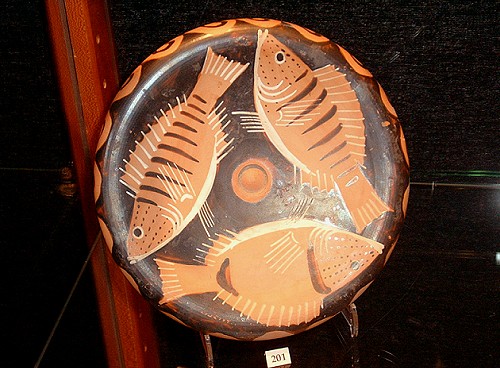 Perhaps, but not consciously.
Perhaps, but not consciously.
The artist has complied with philological care the traditional techniques or innovated without hesitation.
He has created out of his own mind or has drawn from the past for his inspiration.
But his works do not show the memories that would confirm that he had copied some artifact.
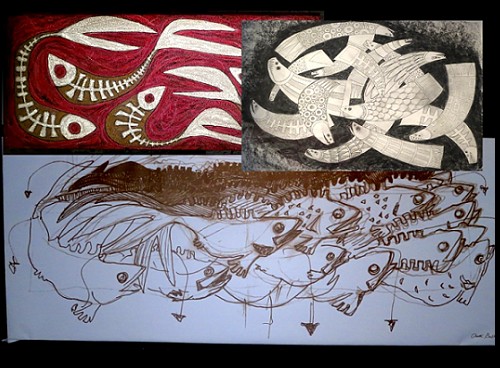 Next to the depiction through painting, sculpture or any other means of expression, of the fish icon and its trajectory - also symbolic - there is the powerful representation of the multitude of fish.
Next to the depiction through painting, sculpture or any other means of expression, of the fish icon and its trajectory - also symbolic - there is the powerful representation of the multitude of fish.
This as well is rendered with the different techniques, ancient or modern, philological or innovative.
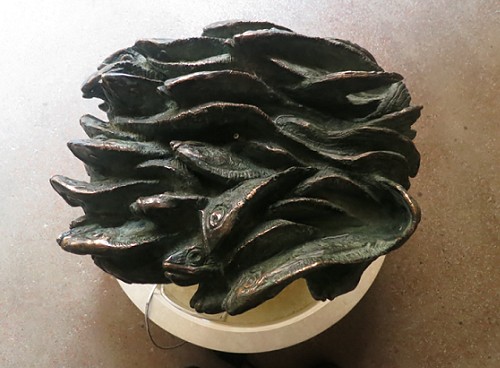 Baldini's works sometimes use existing concepts or stereotypes in unusual ways.
Baldini's works sometimes use existing concepts or stereotypes in unusual ways.
They do so sometimes openly, sometimes more softly, inviting reflection and deepening.
In his bronze fountain, it is not the water that gives life to the fish, but it is a school of darting fish from which the water flows, the source of life, but that in turn requires being nurtured, cared for, admired.
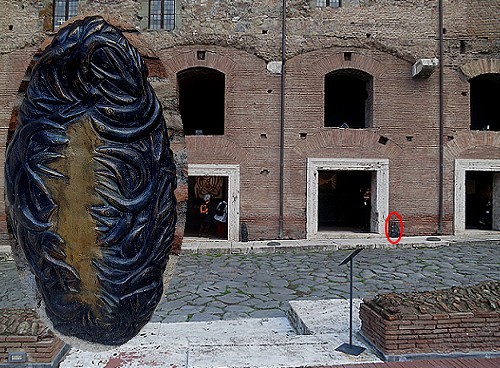 We continue along the path of the semi-circular Via Biberatica, slightly uphill, and following the hilly landscape.
We continue along the path of the semi-circular Via Biberatica, slightly uphill, and following the hilly landscape.
The wise architect from Damascus intervened only when necessary, excavating in the western part of the Quirinal Hill to make room for the forum, while modelling the remaining hillside into an amphitheater to accommodate the structure of markets.
Next to the some of the tabernae bronze monoliths are posted, inspired from Eastern Mediterranean art, which mark the beginning of the next section of the exhibition for the visitor.
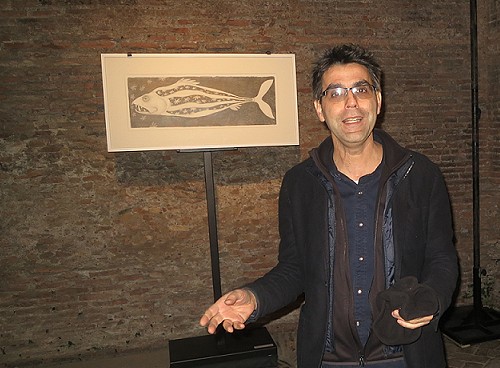 According to Baldini, art should not be far from the person, not necessarily admired from a safe distance, observed only from afar.
According to Baldini, art should not be far from the person, not necessarily admired from a safe distance, observed only from afar.
His works are designed to be not only seen but also explored in their tactile qualities, appreciated by touch.
Also for this, the mosaics are not flat and are made from different materials: to be touched with the hand.
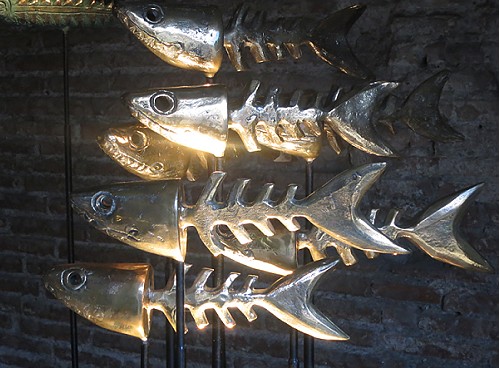 We have already seen how the vision of the works should to be accompanied whenever possible by tasting foods and the like.
We have already seen how the vision of the works should to be accompanied whenever possible by tasting foods and the like.
We have just learned that the mosaics, the bronzes, the bas-reliefs want to be touched by the human hand.
Even more, they must be savored using all the senses.
These works in bronze, mounted on flexible metal rods, are bells.
The hand of the visitor who touches causes them to collide generating a random and unique harmonious sound.
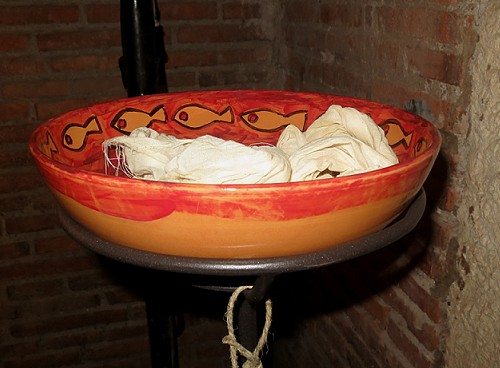 At the entrance to every taberna are bowls, which, of course, are themselves also part of the works created for the exhibition.
At the entrance to every taberna are bowls, which, of course, are themselves also part of the works created for the exhibition.
They contain tissues impregnated with natural essences that evoke scents of the sea and the coasts lapped by the Mediterranean Sea in the visitor.
On special occasions, the visit of the exhibition is also accompanied by music tuned to the event.
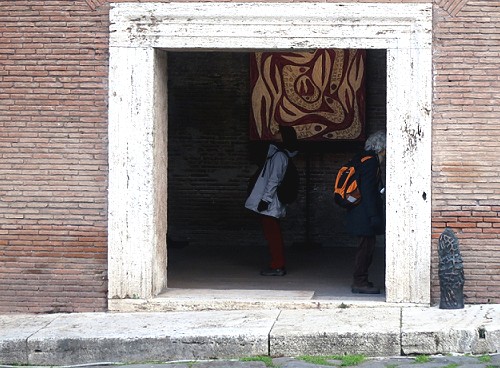
The journey through the exhibition Mediterraneum makes us rethink the beauty and richness we have lost by destroying them with our own hands, and continuing even now, unfortunately, as if we had learned nothing from many past lessons.
Fortunately, the exhibition offers a positive message, which evokes the power of beauty to recognise again the true value for all things, beginning with the nature and - in nature - the sea, which is the origin of everything.
The subdued though powerful environment of these millennial structures, the discreet light at the edge of twilight facilitate the visitor's immersion in the world of artistic representation, without diverting his or her attention.
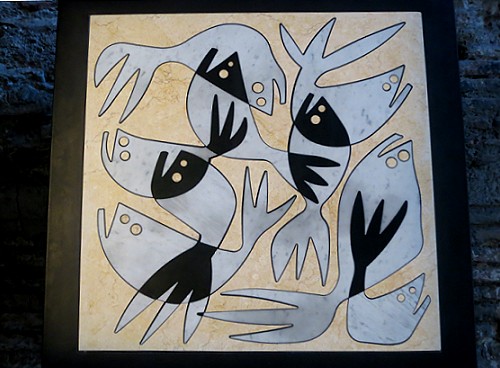 The sources of inspiration provided by the sea are endless, and, paradoxically, seem to be infinite even if you choose to draw inspiration from just one of the many elements, albeit important, marine life: the fish and together with it some other creatures.
The sources of inspiration provided by the sea are endless, and, paradoxically, seem to be infinite even if you choose to draw inspiration from just one of the many elements, albeit important, marine life: the fish and together with it some other creatures.
Equally, the possibilities of expression seem vast thanks also to the artistic techniques used to represent the beauty of the Mediterranean, and the seas in general.
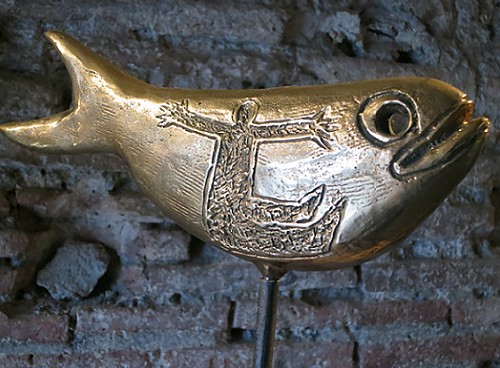 An important part of Mediterraneum is dedicated to man's return to the sea, indeed even in the belly of its creatures.
An important part of Mediterraneum is dedicated to man's return to the sea, indeed even in the belly of its creatures.
It's a legend, found in many cultures, of the Leviathan who swallows the human being, allowing in this way his rebirth into a new awareness.
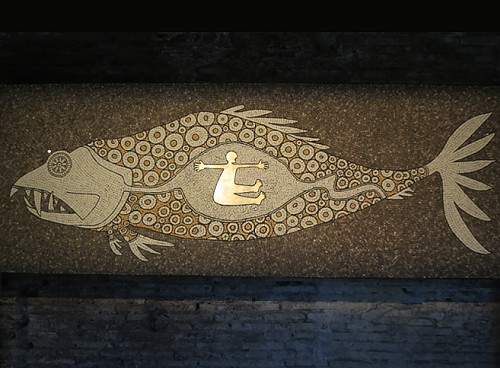 From bronze to gold, which coats many pieces of this mosaic...
From bronze to gold, which coats many pieces of this mosaic...
The theme in this section of the exhibition is always the same, namely the rebirth of man through the necessary acceptance of his cancellation in the primordial matter, the Sea.
Obtained by offering himself as food to the creatures, who will then in turn provide food for the body and the soul, and the strength to look towards the stars.
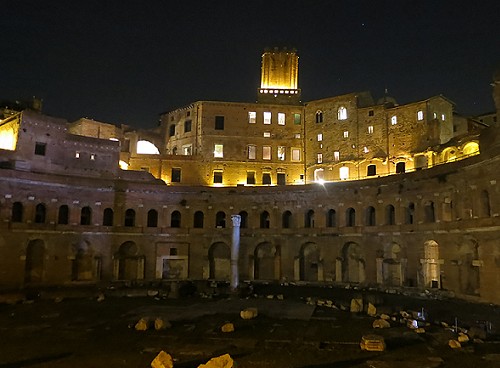 During winter time the sun completes its jourmey very soon.
During winter time the sun completes its jourmey very soon.
When reluctantly leaving the exhibition, it is now dark, but the darkness seems to cloak the man-made environment in a fascinating aura of mystery. It gives that sense of life as invisible yet perceptible that comes from the depths of the seas.
Text and photos by Paolo Bottoni.








